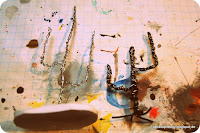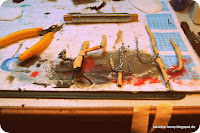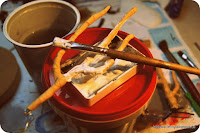 When it comes to wargaming terrain you need - accept from hills and ponds - some nice forests with some good looking trees! But the range of trees is divided into a lot o different types. Same when it comes to model trees. There are leaf trees and conifers in general. More special types you can find in arid climates also known as deserts. There you have typically the cactus. In this tutorial you can learn how to build your model cactus for your wargaming desert scenery.
When it comes to wargaming terrain you need - accept from hills and ponds - some nice forests with some good looking trees! But the range of trees is divided into a lot o different types. Same when it comes to model trees. There are leaf trees and conifers in general. More special types you can find in arid climates also known as deserts. There you have typically the cactus. In this tutorial you can learn how to build your model cactus for your wargaming desert scenery.
 For the main structure of the cactus you need wire. You should bend the wire with a pliers in the right form. Afterwards it is about giving the model cactus or tree a little bit more body. For that I use tape that painters work with. Its raw and so you can put on easily some filler. TIP: I mix filler with PVA - that makes the surface more elastic. Using a brush to apply the filler on the painters tape gives you a great benefit. You already have the texture of a cactus. After applying the filler you can deepen the relief of the cactus bark or the model tree bark by using a needle or nail.
For the main structure of the cactus you need wire. You should bend the wire with a pliers in the right form. Afterwards it is about giving the model cactus or tree a little bit more body. For that I use tape that painters work with. Its raw and so you can put on easily some filler. TIP: I mix filler with PVA - that makes the surface more elastic. Using a brush to apply the filler on the painters tape gives you a great benefit. You already have the texture of a cactus. After applying the filler you can deepen the relief of the cactus bark or the model tree bark by using a needle or nail.  Now it is time for a quick and effective painting. I use the dry brushing technique in combination with some washing. Start with a dark green and work out with some brighter greenish paints. For the last accents it is very nice to have a beige tone. It gives u the certain yellow greenish look of a cactus.
Now it is time for a quick and effective painting. I use the dry brushing technique in combination with some washing. Start with a dark green and work out with some brighter greenish paints. For the last accents it is very nice to have a beige tone. It gives u the certain yellow greenish look of a cactus. Hop you enjoy that tiny tutorial. I made some cactus for my Dark Age Terrain which is located in a desert wasteland scenery called Red Mesa. Just click the orange link for more information!
Hop you enjoy that tiny tutorial. I made some cactus for my Dark Age Terrain which is located in a desert wasteland scenery called Red Mesa. Just click the orange link for more information!
GERMAN: Für eine ausgewachsene Partie Tabletop braucht es natürlich auch das passende Gelände. Da ich gerade an einem Projekt für die Hersteller des Spiels DARK AGE sitze und dieses Scenario in einer Wüstengegend spielen soll, habe ich mich dazu entschlossen ein paar nette Kakteen zu bauen.
 Wie beim Bau eine Modellbaumes erstellt man das Grundgerüst am besten aus Draht, welchen man in die richtige Form biegt. Danach wird der Draht mit Klebeband für Malerarbeiten umklebt. Darauf haftet die nächste Schicht Spachtelmasse besonders gut. Letztere wird mit Leim vermischt, um eine höhere Elastizität zu erhalten.
Wie beim Bau eine Modellbaumes erstellt man das Grundgerüst am besten aus Draht, welchen man in die richtige Form biegt. Danach wird der Draht mit Klebeband für Malerarbeiten umklebt. Darauf haftet die nächste Schicht Spachtelmasse besonders gut. Letztere wird mit Leim vermischt, um eine höhere Elastizität zu erhalten.
Man kann auch das saugfähige Klebeband mit einer verdünnten Wasser-Leim-Mischung aushärten. Durch das auftragen von Spachtel mit einem Borstenpinsel ergibt sich schon eine rillige und für einen Kaktus typische Oberfläche.
 Bemalt wird mit Acrylfarbe, man arbeitet sich über verschiedene heller werdende grüne Farbtöne mit der Technik "Trockenbürsten" bis zum erwünschten Ergebnis voran. Um die Akzente zu vertiefen wird noch mal getuscht und mit Beige oder Gelb akzentuiert. FERTIG!
Bemalt wird mit Acrylfarbe, man arbeitet sich über verschiedene heller werdende grüne Farbtöne mit der Technik "Trockenbürsten" bis zum erwünschten Ergebnis voran. Um die Akzente zu vertiefen wird noch mal getuscht und mit Beige oder Gelb akzentuiert. FERTIG!
Best / Bestes
TT-Lenny


Keine Kommentare:
Kommentar veröffentlichen